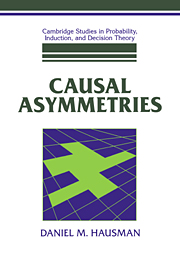Book contents
- Frontmatter
- Contents
- List of Figures
- Acknowledgments
- Introduction: Causation and its Asymmetries
- 1 Metaphysical Pictures and Wishes
- 1* Transfer Theories
- 2 Is Causation a Relation Among Events?
- 3 Causation, Regularities, and Time: Hume's Theory
- 4 Causation and Independence
- 4* Causation, Independence, and Causal Connection
- 5 Agency Theory
- 5* Causal Generalizations and Agency
- 6 The Counterfactual Theory
- 6* Independence and Counterfactual Dependence
- 7 Counterfactuals, Agency, and Independence
- 7* Agency, Counterfactuals, and Independence
- 8 Causation, Explanation, and Laws
- 8* Causation, Explanation, and Independent Alterability
- 9 Probabilistic Causation
- 10 Causation and Conditional Probabilities
- 10* Causal Graphs and Conditional Probabilistic Dependencies
- 11 Intervention, Robustness, and Probabilistic Dependence
- 11* Interventions and Conditional Probabilities
- 12 Operationalizing and Revising the Independence Theory
- 12* Probability Distributions and Causation
- 13 Complications and Conclusions
- Appendix A Alphabetical List of Propositions
- Appendix B List of Theorems
- References
- Index
4* - Causation, Independence, and Causal Connection
Published online by Cambridge University Press: 20 April 2010
- Frontmatter
- Contents
- List of Figures
- Acknowledgments
- Introduction: Causation and its Asymmetries
- 1 Metaphysical Pictures and Wishes
- 1* Transfer Theories
- 2 Is Causation a Relation Among Events?
- 3 Causation, Regularities, and Time: Hume's Theory
- 4 Causation and Independence
- 4* Causation, Independence, and Causal Connection
- 5 Agency Theory
- 5* Causal Generalizations and Agency
- 6 The Counterfactual Theory
- 6* Independence and Counterfactual Dependence
- 7 Counterfactuals, Agency, and Independence
- 7* Agency, Counterfactuals, and Independence
- 8 Causation, Explanation, and Laws
- 8* Causation, Explanation, and Independent Alterability
- 9 Probabilistic Causation
- 10 Causation and Conditional Probabilities
- 10* Causal Graphs and Conditional Probabilistic Dependencies
- 11 Intervention, Robustness, and Probabilistic Dependence
- 11* Interventions and Conditional Probabilities
- 12 Operationalizing and Revising the Independence Theory
- 12* Probability Distributions and Causation
- 13 Complications and Conclusions
- Appendix A Alphabetical List of Propositions
- Appendix B List of Theorems
- References
- Index
Summary
This chapter will clarify details, especially concerning logical relations among CC, I, and CP.
The Operationalizing Assumption and the Connection Principle
Recall that the connection principle says:
CC (Connection principle) For all events a and b, a and b are causally connected if and only if they are distinct and either a causes b, b causes a, or a and b are effects of a common cause.
“Causal connection” is a primitive – but I defended the following approximation:
OA (Operationalizing assumption) Events or tropes a and b are causally connected if and only if a and b are distinct and the kinds a and b or the properties A and B are in the background circumstances probabilistically dependent.
As I shall explain at greater length in chapter 5*, generalizations about relations among types or properties, whether these are deterministic like DC or probabilistic like OA, must carry a reference to the “circumstances.” For example, in most circumstances there is a correlation between consuming highly acidic foods and stomach pains. In circumstances in which one has already ingested an alkali, this correlation can be reversed. The overall association depends on the de facto frequency of different circumstances. Although the unconditional probabilistic dependence between A and B is a reasonable guide to whether a and b are causally connected, one's operationalization of the notion of causal connection ought not to depend on de facto frequencies. So one should link causal connection to probabilistic dependence “in the background circumstances.”
- Type
- Chapter
- Information
- Causal Asymmetries , pp. 75 - 85Publisher: Cambridge University PressPrint publication year: 1998



